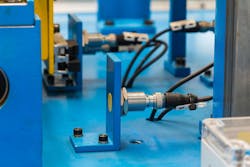Key highlights
- Presence sensing technologies, from traditional limit switches to modern proximity, photoelectric and ultrasonic sensors, have their own operational principles and ideal applications.
- Distinguish between inductive (conductive objects) and capacitive (non-conductive objects) proximity sensors, along with the trade-offs of shielded versus unshielded designs.
- Photoelectric sensors (thru-beam, retro-reflective, diffuse) and ultrasonic sensors have unique advantages for detecting objects, including liquids and granular materials.
A key element of any control-system design is accurately determining if an object is present. This might come in the form of sensing the position of a driven device, extended or retracted or somewhere in between, or just the simple presence of an object in a general sense, thus triggering further action.
Depending on the object being detected, a number of different methods of sensing can be used. In many cases, multiple methods can be used with comparable results.
The most common sensor classes are proximity, photo-electric, pressure, temperature, sonic or ultrasonic, motion, flow, force, load, level and position, or limit, sensors but further classes exist. Presence sensing is the method of determining if an object is present.
At the base level, the most simplified version of a sensor used to determine presence would be a limit or position sensor. This device uses physical contact to displace a lever to complete or break a circuit through which current is running.
For example, a lever connected to a normally closed contact with springs to keep it in position would indicate the presence of an object when the lever is acted on with enough force to displace the lever and break the contact. This would work in a similar way if the contact was normally open and displacement of that same lever would “make” the contact when an object applies force to the lever.
In reality, every presence-sensing device is a variation of the limit switch. By using some method to detect the presence or absence of an object, the internal contact of the sensor will either be made or broken. The method by which the object is sensed will vary but the purpose remains the same.
One such sensing device is the proximity switch. This device, as the name suggests, counts on the close proximity of an object to make or break contact without making physical contact with the device. There are two main types of proximity switch, inductive and capacitive. The difference has to do with the electrical characteristics of the device.
The capacitive switch detects the change in capacitance caused by the presence of a nearby object. It works by creating an electrostatic field and then measuring the change in that field caused by the introduction of an object to that field.
An inductive sensor, on the other hand, detects changes in an electromagnetic field when a conductive metal object is close by.
The key difference is electrostatic vs. electromagnetic. Inductive sensors are used to detect conductive objects, while capacitive sensors are used to detect non-conductive objects. Examples of each object would be a metal tab or piston for inductive and a piece of wood or cardboard or plastic for capacitive.
The size of the field determines the effective sensing range of the device. Generally, capacitive sensors are limited in size because the amount of available field with which to sense is more limited than the inductive version.
Both sensors come in shielded and unshielded versions. This uses the principle that fields are generated in a mushroom shape off the effective face of the sensor. In an unshielded device, the sensing area is determined only by the size of the sensor face and, as such, can be quite large and inaccurate. By shielding the sides of the sensor at the face, we can limit the spread of the mushroom into more of a cylinder shape, thus gaining more accuracy by limiting the bloom effect of the unshielded field.
However, shielding a sensor reduces the sensing range off the face of the sensor so the device must be much closer to the object being sensed. If there is any variation on the path of the object when moving, there is risk of striking the sensor with the object. It is best, therefore, to place the sensor perpendicular to the path of the object rather than directly in the path where one might rely on the sensor to stop motion before the object strikes the sensor.
Another very popular presence sensing device is the photoelectric sensor, also referred to as a photo-eye. As the name suggests, this sensor produces and then detects a beam of light. There are three types of photoelectric sensors—through-beam, diffuse or proximity and retro-reflective. All three types have both an emitter and collector of light source.
For a through-beam, the emitter and collector are in two separate containers while both retro-reflective and diffuse sensors have the emitter and collector in the same physical body. When an object is introduced to that path of light, the beam is interrupted, and the sensor detects the presence of the object.
Get your subscription to Control Design’s daily newsletter.
The through-beam sensor is quite simple in function. In normal operation, the light emitted by one half of the pair is detected by the other half of the pair. If an object enters the path of the light in the pair, a switch in the receiving side is triggered. The pair can be set up to be normally closed/on when light is present or normally open/off when light is present. This sensor can be difficult to set up as the emitter and receiver must be in near-perfect alignment. This might be difficult to do over longer distances between emitter and receiver.
The other two methods work the same way but differ in the way that the emitted light gets to the receiver. For retro-reflective, the emitted light is bounced off of a reflector and back to the receiver. Since, like the through-beam, the light is being interrupted to detect an object, any object that blocks light can be detected.
For a diffuse sensor, the emitted light is bounced off of the object being detected and back to the receiver. For this reason, the object to be detected must have reflective properties. If it absorbs light, then it cannot be detected by a diffuse sensor. Remember that the emitter and receiver are in the same physical body for both the retro-reflective and diffuse sensors, so path of the beam out and back are relatively narrow.
A third method of sensing makes up the presence sensing devices—ultrasonic. This uses some of the same principles of a light-emitting sensor, but it uses sound waves instead of a light beam. The sensor sends out high-frequency sound waves and then measures the time it takes for the sound to reflect back after striking an object. In its base form, a sonic sensor can simply indicate that sound has been reflective but, to be more accurate, the time it takes for the sound to return is used in most applications.
For example, if we are sensing an approaching object, we likely don’t want to know just that a reflected sound wave has been detected but that a particular sound wave has been detected within an expected time differential and, thus, the distance away from the sensor. Since the speed of sound in air is a known quantity, this type of sensor can lend itself well to the detection of liquids or granular products, particularly in vessels like tanks or hoppers. It can also be used to detect the approach of a car or person into a known workspace.
An interesting note on all of the sensors discussed, the packages are very similar in size and mounting methods. While the three types of sensors make up most of the presence-sensing devices, variations of these can also be used. For example, an area scanner uses the principles of a diffuse photo-eye to sense a person or object in a much larger workspace. This is done by mounting the send/receive device on a multi-axis device that moves in all directions of a defined space to create a three-dimensional scan area.
Due to the need to send and receive at much higher rates to cover the whole area effectively, the light source is usually a laser or infrared laser. Typical photosensor wavelength is in the near-infrared and visible-light spectrum, while laser operates in the ultraviolet to infrared range.
An area scanner uses a mirror to deflect the light source rather than moving the light source around. The ultra-fast vibration movement of the mirror allows for a significant area to be scanned in a very short time span.
Other sensing methods can be utilized for presence sensing. For example, a presence or force sensor or load cell can be used to detect the presence of an object. One example of this would be a safety mat that an operator would stand on while operating a press.
Presence sensing can take many forms. New technologies offer better, more accurate versions, but the basic principles remain. Of course, with most sensors these days, IO-Link is a standard offering, and this adds an extra element to a control design with value-added information available from the sensor to help with troubleshooting and data analytics.
About the Author
Rick Rice
Contributing Editor
Rick Rice is a controls engineer at Trew Automation, a material handling manufacturer based in West Chester, Ohio. With over 38 years’ experience in the field of automation, Rice has designed and programmed everything from automotive assembly, robots, palletizing and depalletizing equipment, conveyors and forming machines for the plastics industry but most of his career has focused on OEM in the packaging machinery industry with a focus on R&D for custom applications.

Leaders relevant to this article:

